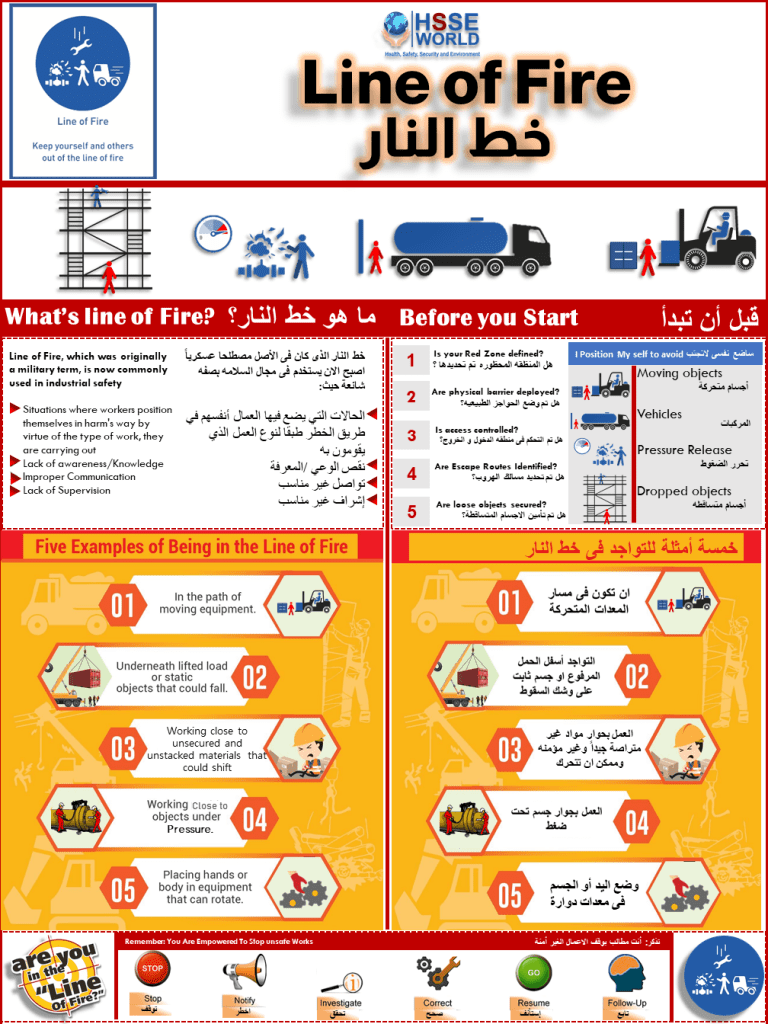Video: Avoiding line of Fire: Safety Moment#36
4 min readThe term “line of fire” in safety is very common when talking about the hazards of a work task. Depending on the work being completed, there could be many different lines of fire or there could be very few. It is important to understand what the line of fire is and how to avoid being in it to avoid injuries. What is the line of fire? A simple definition is being in harm’s way. Line of fire injuries occurs when the path of a moving object, or the release of hazardous energy, intersects with an individual’s body.
The live-action video below demonstrates safe work practices and examples of Line of fires and how to avoid unsafe work practices exposed workers to the line of fires
Watch the Video
There are three major categories of line of fire incidents:


- Caught-in or between A construction worker is standing between a wall and an excavator. When the excavator spins around the counterweight pins the worker against the wall. Another example would be a worker placing his hand too close to a rotating gear and gets it pulled into the gear.
- Released energy: A pipe releasing hot steam from a valve that is being removed or a flame shooting out of a malfunctioning engine are examples of released energy.
- Struck by: A pedestrian struck by a moving vehicle or an object falling from a higher level striking a worker below are examples of struck-by incidents.
Avoiding Line of Fire Incidents:
The best way to avoid the mentioned incident types is to identify and eliminate line of fire hazards whenever possible. By eliminating the hazards, there is no chance that you or anyone else in the work area can be injured by that hazard.
When elimination is not possible, engineering controls are the next best choice in protecting yourself from injury. Some engineering controls that could protect you from line of fire incidents include physical barriers, guarding around moving parts, and toe boards on elevated work platforms to prevent objects from falling to the area below. There are many other possible engineering controls that could be used depending on the specific hazard.
Total elimination of hazards is not always possible and engineering controls may not be feasible or they can fail. Because of this reality, it is important to decrease your chance of being a victim of line of fire injuries by not putting yourself in harm’s way in the first place. Understand the work tasks that are going on around you and the associated hazards. Ask yourself what is the worst that can happen or what will happen if a certain safeguard fails. Recognize the hazards of your work and act accordingly.
Line of fire Safety Flash


Download PDF File of Safety Flash
More Safety Moments
- 15 Home Insurance Safety Tips to Lower Premiums
- Scaffolding Safety Tips
- Vehicle Backing Safety Facts
- Gasoline Safety Tips
- Photo of the day: Flood Safety Tips
- Video: Avoiding line of Fire: Safety Moment#36
- Video: Aerial Work Platform Safety: Safety Moment#35
- How to use Plate Clamps Safely: Safety Moment#34
- Photo of the day: Incident Investigations
- Photo of the day: 10 Scaffold Safety Essentials
- Tips to Avoid Standstill Accidents: Safety Moment#33
- Common Causes of the workplace incident: Safety Moment#32
- Machinery Guarding: Safety Moment#31
- Electrical Safety While Working From Home: Safety Moment#30
- Cranes Stability and Tipping: Safety Moment#29
- Safety Net Regulations: Safety Moment#28
- Quick Tips for Avoiding Pinch Point Injuries: Safety Moment#27
- Video: Working safely Near powerlines -Safety Moment#26
- Video: Winter’s Hidden Hazard -Safety Moment#25
- Video: Isocyanates Exposure -Safety Moment#24
- Video: Electrical Safety Awareness -Safety Moment#23
- Oil & extraction: hazards, controls & resources -Safety Moment#22
- Exposure Limit Terms -Safety Moment#21
- Keeping Warehouse Personnel Safe 6 Key Tips -Safety Moment#20
- Understanding RF radiation-Safety Moment#19
- Annual inspection and certification requirements for mobile cranes and boom trucks-Safety Moment#18
- 66 Safety Tips at work-Safety Moment#17
- Tick’s Threats when working outdoors -Safety Moment #16
- Hidden Hazards:25 steps to a safer office -Safety Moment #15
- Falls from heights :Video-Safety Moment #14
- Practice caution when handling fuel-Safety Moment #13
- The Golden safety rules :Video-Safety Moment #12
- Don’t ignore shoulder pain-Safety Moment #11
- Explain chemical Data Sheets For Non-Technical People-Safety Moment #10
- Cleaning chemicals Tips: Know the risks -Safety Moment #9
- Risk of Explosion during Removal of Split Rim/Multi Piece Wheels from Vehicles-Safety Moment #8
- Abrasive blasting: Know the hazards -Safety Moment #7
- Electrical Safety Tips -Safety Moment #6
- Tips to prevent heat illness -Safety Moment #5
- Know how to handle a hammer -Safety Moment #4
- Arc Flash Protection -Safety Moment #3
- Working safely with cement -Safety Moment #2
- Flammable Liquid Storage -Safety Moment #1



